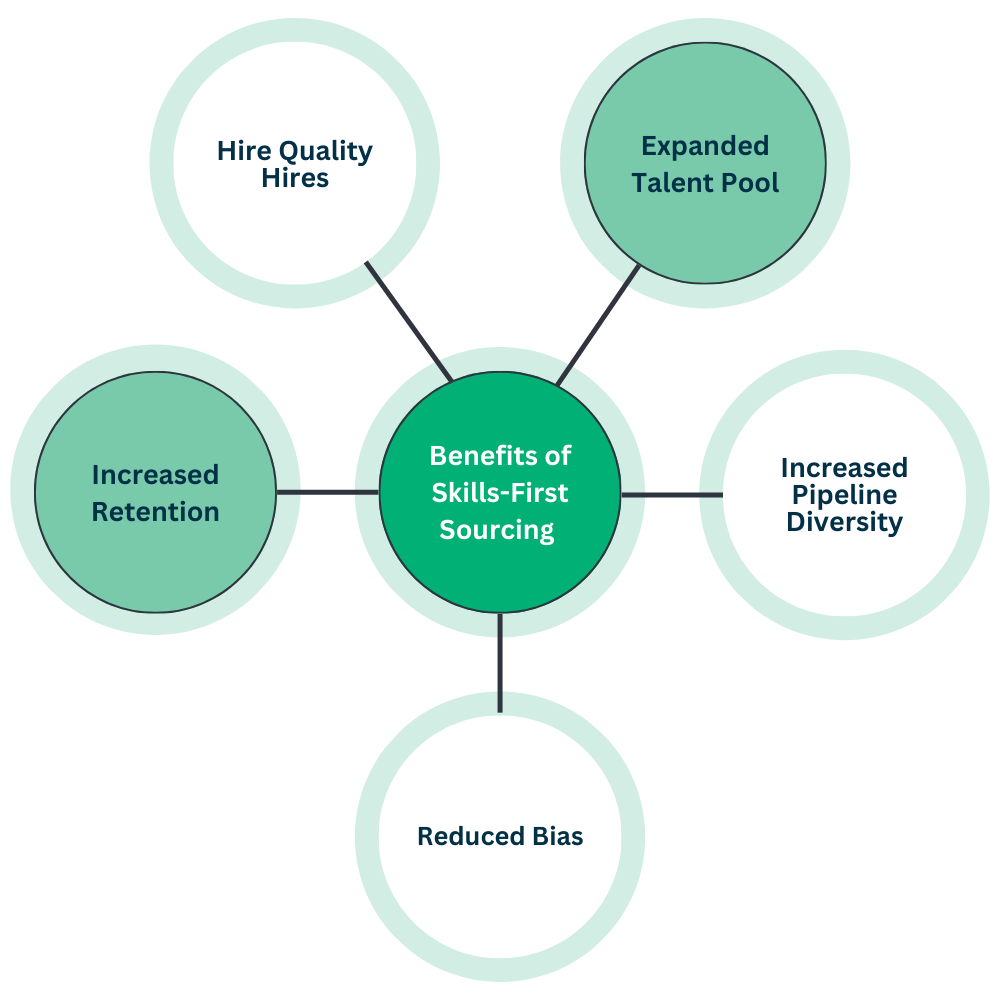By the end of your work day, if you’ve sourced a dozen hard-to-find candidates, your passive talent pipeline is full, shiny, and healthy, and you’ve still got enough energy and time left over to go do that thing you love. Congratulations! We hope the two of you have a great evening.
For everyone else, check out our quick guide to common talent sourcing challenges and try out some of our practical solutions to help fix those problems.
Challenge 1: Attracting Best-Fit Candidates
Finding the perfect hire for a niche role is like finding a needle in a bunch of other needles. Sifting through volumes of resumes and applications to find candidates with the critical skills you’re looking for often requires high levels of effort for surprisingly low rewards.
This disparity has only gotten worse as candidates take advantage of AI’s automation and generative capabilities to flood the market with applications.
This can result in posts open for months, lower productivity, hindered innovation, and the financial and psychological expense of a hire that doesn’t work out.
Solution: Skills-First Sourcing
Power up your talent acquisition strategy with skills-first sourcing. Skills-first sourcing and hiring shifts the emphasis on traditional requirements, like qualifications or experience, in favor of demonstrable skills – and the approach is on the rise.
How To Do It
- Reduce application barriers for best-fit candidates by eliminating unnecessary traditional requirements, like industry experience or qualifications. These may stand as proxies for the required skills, but they don’t always predict real skill levels.
- Rethink job descriptions to articulate the skills required, and define an acceptable evidence of mastery.
- Focus on transferable skills. For instance, a skilled project manager, software designer, or customer service strategist with experience in one industry or role can easily transfer those skills to another.
- Research unexplored talent pools. If you look in the same places, you’ll find the same candidates. Explore traditionally underserved candidates who may have been excluded from education or employment opportunities, yet nevertheless wield the valuable skills you’re looking for.
Getting Skills – First Sourcing Right

(Source: LinkedIn)
Challenge 2: Building A Resilient Passive Talent Pipeline
We’ve all seen a fair bit of upheaval over the last few years. Like COVID-19. The Great Resignation. The Big Stay. AI-powered jobshifts.
The one thing that’s certain about the job market is that it’ll stay weird. If you remain reactive, you’re more at risk of talent shortages, increased time-to-hire, disruption when employees leave – and they will leave – and difficulties adapting to change.
Solution: Deploy A Talent Pipeline Strategy
Two things will enable you to perform, whatever the world throws at you.
The first is a proactive mindset, which focuses on hiring for future needs (even if you’re not yet sure what they are). The second is a healthy, robust talent pipeline that’s packed with engaged, pre-qualified candidates primed and ready to seize the right opportunity when it emerges.
How To Do It
- Leverage data analytics for an evidence-based approach to building your pipeline. Consider using:
- Workforce forecasting to better understand the skills and areas of expertise you need.
- Historical data analysis and your ATS to reveal the best sources (so far) of successful hires and high-performing employees.
- Effort forecasting to predict how much talent sourcer resources you’ll need to attract pipeline-building targets.
- Create and maintain a standout employer brand. A magnetic brand has the power to engage talent for you. Passive candidates stay interested if a brand consistently shares their values and articulates clearly that they offer what candidates actually want.Think through every touchpoint – from job ads, websites, social media, and careers pages, to chatbots, your Glassdoor review responses, and beyond.
- Get creative about finding passive candidates. Passive candidates are everywhere, if you know where to look.Partner with colleges and organizations that champion underrepresented people, and stay connected with silver medalists and other candidates that didn’t get the job. Lurk on professional networks.Abuse Boolean strings like nobody’s watching. Investigate social media influencers. Review candidates lower down on your search results. Create employee referral schemes that reward the referral, not the hire.
- Personalize engagement. If you demonstrate genuine respect for, interest in, and curiosity about your candidate, you’ll create a meaningful human connection that makes them feel understood, valued, and engaged. Personalized communication drives this kind of nurturing as part of a positive candidate experience. Ask questions. Be useful.
- Make it easy for the candidate to stay engaged by reducing friction. Use the communication channels they prefer. Avoid duplicate and multi-level application processes or anything else that’s a pain in the butt for them.
Challenge 3: There’s Never, Ever Any Time
It’s a vicious cycle: the drudgery of manual, time-consuming tasks amplifies the pressure on sourcers to deliver viable candidates in ever-reducing timelines.
Everyday stresses pose major roadblocks to effective talent sourcing, like the frustration of losing track of promising candidates, which highlights your exasperation with the time and headspace you desperately need to develop a robust reminder system.
What’s worse is that these mundane irritants often what leads sourcers down the path to burnout.
Talent sourcers and recruiters need time: time to create and deploy effective sourcing strategies. Time to authentically connect with candidates.
Time to build productive long-term relationships and find hard-to-reach candidates. And time to have a life at the end of the workday.
Solution: Automate What You Can
AI-driven automation relieves recruiters of time-consuming and repetitive tasks, giving them back the time and energy to focus on tasks where being a human makes all the difference, like enriched candidate engagement and building productive relationships. Your ATS is only part of it.
AI-based sourcing tools like Visage are especially good at helping you identify, attract, and nurture hard-to-reach and diverse passive candidates.

How To Do It
- Be clear about your objectives. What outcome are you looking for? As with any new tech adoption, ensure it aligns with your business goals.
- Get a clear picture of what’s on the market. The expansion of AI tools is such that you’ll find something you never knew you needed. Visage, for instance:
- Helps you hire at volume via automated candidate search, qualified by humans.
- Saves days of research with automated profile mining, for rich information ready for personalized engagement.
- Allows recruiters to create personalized smart campaigns, using customizable templates, scheduled delivery, customized cadence and automated follow-up.
- Reduces unconscious bias by stripping out images and parsing resumes for consistency.
- Forecasts sourcing effort, using machine learning and pattern recognition.
- Prepare the ground by easing any residual fear sourcers may have of being replaced by AI. Explain how it’s a pivot into higher-quality work. Skill up staff to be AI-fluent. Make sure they have time to practice, learn and make mistakes.
What’s Your Biggest Talent Sourcing Challenge?
Whatever your biggest challenge may be, we’re here to make life easier. The Visage approach blends powerful, ethical AI with a 4000+ strong team of diverse human sourcers from around the world. Curious about what we can do for you? Reach out for a demo now.

Director of Sourcing Operations at Visage, Evelyn has experience in agency, RPO, and in-house roles spanning 12 years in the recruitment industry. Evelyn has built and oversees a 4000-member global freelance sourcing community. Every Christmas in Ireland, she enjoys putting up her THREE Christmas trees.

